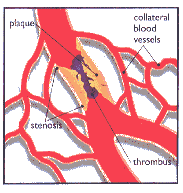 Like the appendix , collateral circulation is another part of our anatomy that was more useful to our ancestors. Collateral circulation refers to systems of veins and arteries that allow blood to continue flowing when the main pathway is blocked or damaged.
Like the appendix , collateral circulation is another part of our anatomy that was more useful to our ancestors. Collateral circulation refers to systems of veins and arteries that allow blood to continue flowing when the main pathway is blocked or damaged.
These extra vessels sometimes develop in response to a circulation blockage. But certain parts of the body – the elbows, knees, shoulders – are equipped with these redundant vessels right from the start.
We’re not born with collateral circulation in those really important places like the brain and the heart. Why would we have these surplus vessels in the elbows, but not in the places that keep us alive?
The location of collateral vessels makes sense if you consider how long our ancestors lived. Our bodies evolved while the human lifespan was short. Strokes and heart attacks – affecting the brain and the heart – happen when humans reach their 50s and 60s.
Living that long is a very recent development. In 1900, the average lifespan (PDF) around the globe was 31 years. Even in the richest countries it was below 50. There was no need for extra vessels surrounding the heart and brain because those organs were less likely to be damaged than elbows, knees, and shoulders.
The way we live our lives today is very different from even 100 years ago. Our bodies, however, have not yet changed.
Collateral circulation in cats
Cat owners may be familiar with collateral circulation to the rear legs of their pets. A blood clot can lodge in the cat’s pelvis, where the aorta from the heart joins the arteries that supply the back legs. When this happens, the cat will have difficulty moving, the back legs will be cold, and the nails may be blue. There is adequate collateral circulation, however, to keep the tissues alive. Immediate veterinary attention can dissolve the clot and restore function.
Here’s a video of a cat, Nora, whose front legs are working especially well. I find this video strangely moving. It suggests connections between human and animal worlds that are normally outside of our awareness.
This is a one-minute excerpt from the five-minute concert. The complete performance is available on YouTube. It’s also available on the CATcerto website, which includes additional videos and interviews with both Nora and the composer/conductor.
A big thank you to my Rosen Method colleague and Facebook friend, Marie-José Thijssen, for providing this link.
Related links:
Still useful after all these years: The appendix
Still useful after all these years: The spleen
Still useful after all these years: The gall bladder
Sources:
(Links will open in a separate window or tab.)
Maggie Koerth-Baker, Vestigial Organs Not So Useless After All, Studies Find , National Geographic, July 30, 2009
Drs. Foster & Smith, The Cat with Blue Claws, PetEducation.com


Sorry, comments are closed for this post.